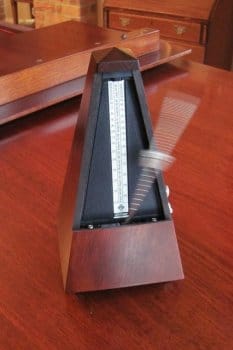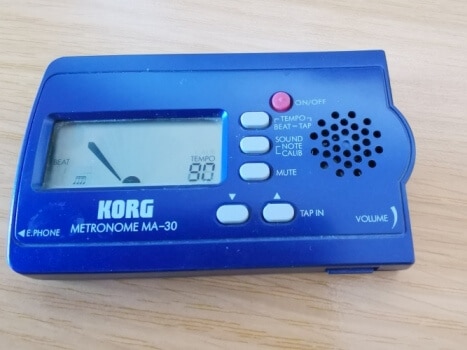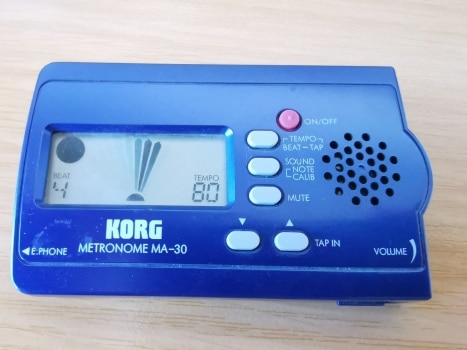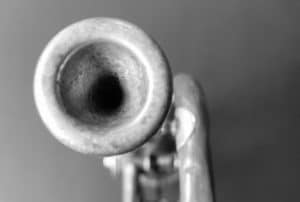A metronome can help you a great deal if you want to take your rhythm skills to the next level. We’ll look at how you can use a metronome for trumpet playing to become a better trumpet player.
What different kinds of metronome are there?
Before you get started, you’ll need to pick a metronome There are two different kinds:
Analog wind-up metronome

You’ve no doubt seen this one around. It’s a little box with a pendulum that lets you set different speeds. As the pendulum swings, it gives you both a visual indicator of the speed of the rhythm as well as an audible click for each beat.
Pros
- Will never run out of battery
Cons
- Less accurate than digital metronome
- Loudness of clicks can’t be adjusted
- Large, not convenient to carry around
- Only covers conventional rhythms
Digital metronome

Digital metronomes do the same thing as analog ones, they indicate a rhythm with clicks or beeps while showing a visual indicator of the rhythm at the same time. They’re available as stand-alone gadgets or as an app for Android or iPhones.
My recommendation
I’ve had my Korg Metronome* for over 20 years now and it remains a reliable tool for practicing. It’s small enough to fit in any bag, it’s got a volume control wheel, it covers many speeds and rhythms and you can plug in headphones to avoid it showing up in any recordings. The battery life of this little gadget is also incredible.
Pros
- Small, easy to carry
- Volume can be adjusted
- Many rhythms available
- Has a headphone output
- Speed can be “tapped in”
Cons
- Batteries can run out
Get to know your metronome’s settings
To use your metronome effectively, it helps to get to know the different features it offers. An analog metronome most likely will only offer a “beats per minute” (bpm) value. This will not come as a surprise to you, but the beats per minute value indicates how many beats (or clicks or beeps) there are in one minute at the indicated speed.

Here you can see my Korg metronome doing a 4/4 beat at 80 BPM, the visual indicator in mid-swing. 4 here means that you have 4 beats per bar, so this value influences the accent you will here. Digital metronomes usually use high and low beeps to differentiate accented notes.
So while a 4/4 beat will sound like this:
Beep, boop, boop, boop, beep, boop, boop, boop, etc.
A 3/4 beat sounds like this:
Beep, boop, boop, beep, boop, boop, etc.
The rhythm you need will be indicated in your sheet music.
Using a metronome to work on your timing
A metronome can be a useful tool to work on your general ability to keep time. Keeping time means you start with a speed of 80 BPM and continue with it during the whole musical piece.
It’s very easy to accidentally speed up or slow down a bit, especially if you’ve not practiced keeping time. If you play in a band with a drummer, it will be a lot easier to keep time if your drummer does, but this is generally a very useful skill to have as a musician.
Here’s how to practice keeping time:
- Set your metronome to a BPM value of your choice
- Clap or tap along as well as you can
- Pay attention if you’re slowing down or speeding up and adjust
Once you’ve practiced this for a while and think you’re getting the hang of it:
- Play a note on your trumpet in time with the beat
This is not a one-time exercise but an exercise you can integrate into your practice sessions every day or every week. Like any skill, you need practice to master keeping time.
Using a metronome to practice a particular piece
The other main way of using a metronome is to practice a particular piece slowly and then speed up.
If you’re playing a piece with some technical difficulties or a piece that requires a lot of very fast notes, a metronome can help you master it step by step.
- Pick a speed that is a good bit below what you feel comfortable.
- Keeping time, play the notes one by one. This should feel easy.
- Every time you play the piece increase the speed slightly.
- If you stumble across a passage at the low speed, practice it until it becomes comfortable before you increase the speed again.
With this method, you’ll be breezing through your pieces before long.
Note
You can also use the metronome in this way for particularly difficult passages in a piece that you struggle with. Just keep playing the passage at a very low speed and increase the speed by a few beats per minute as soon as it feels comfortable.
The advantage to doing this rather than practicing at your target speed is that this way you can make sure you are learning the actual notes by heart. If you practice a fast passage quickly, there’s a tendency to play an approximation of it that sounds very close at high speeds.
TrumpetHub.com is a participant of the Amazon Services LLC Associates Program, an affiliate advertising program. Links marked with an asterisk (*) are affiliate links. If you buy a product through an affiliate link, we will get a small commission without extra cost to you. This helps us earn an income off the free content we provide to you. Thank you for your support!






